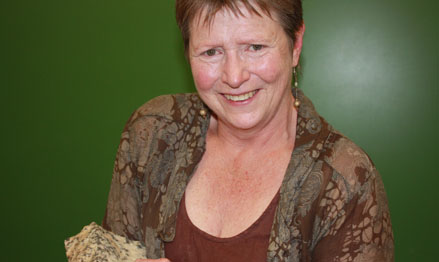Latest News Archive
Please select Category, Year, and then Month to display items
07 June 2019
|
Story Eugene Seegers
|
Photo Barend Nagel
 Tap on the red button labelled ‘Student Login’ at the bottom of the app to log in with your UFS student credentials.
Tap on the red button labelled ‘Student Login’ at the bottom of the app to log in with your UFS student credentials.
What? Your new KovsieApp is here!
How? Download this mobile app to your phone from the Apple App Store or Google Play Store.
Why? To access your information from the UFS website (current, registered students only ??).
It’s free! While you are connected to the on-campus Wi-Fi network.
Campus life just became a whole lot simpler. With the app, you can access personal information like study records, marks, class and exam timetables, mini fee statement, etc.
How to log in
Log in like this:
- Download the app, of course.
- Tap on the red button labelled ‘Student Login’ at the bottom of the app (see screenshot).
- Log in with your UFS student credentials.
- An OTP (one-time pin) will then be sent to the cellphone listed on your student profile. Do we have your correct number?
- Enjoy easy access to your personal UFS information with the KovsieApp! Unless…
… we don’t have your correct cellphone number. Please update your most recent contact number to get to your personal information in the app.
Updating your details
Please update your cellphone number by using the Student Self-service page on KovsieLife if you have trouble logging into or using the app.
Download Links
WATCH: Send the ravens!
Prof Tredoux turns theories regarding the formation of metals on its head
2013-09-17
|
 |
|
Prof Marian Tredoux
17 September 2013 |
The latest research conducted by Prof Marian Tredoux of the Department of Geology, in collaboration with her research assistant Bianca Kennedy and their colleagues in Germany, placed established theories regarding how minerals of the platinum-group of elements are formed, under close scrutiny.
The article on this research of which Prof Tredoux is a co-author – ‘Noble metal nanoclusters and nanoparticles precede mineral formation in magmatic sulphide melts’ – was published in Nature Communications on 6 September 2013. It is an online journal for research of the highest quality in the fields of biological, physical and chemical sciences.
This study found that atoms of platinum and arsenic create nanoclusters, long before the mineral sperrylite can crystallise. Thus, the platinum does not occur as a primary sulphur compound. The research was conducted at the Steinmann Institute of the University of Bonn, Germany, as well as here in Bloemfontein.
Monetary support from Inkaba yeAfrica – a German-South African multidisciplinary and intercultural Earth Science collaborative of the National Research Foundation (NRF) – made this research possible. Studies are now also being conducted on other metals in the precious metal group, specifically palladium, rhodium and ruthenium.
The discovery of the nanoclusters and the combination with arsenic can have far-reaching consequences for the platinum mine industry, if it can be utilised to recover a greater amount of platinum ore and therefore less wastage ending up in mine dumps. This will signify optimal mining of a scarce and valuable metal, one of South Africa’s most important export products.
For Prof Tredoux, the research results also prove thoughts she already had some twenty years ago around the forming of platinum minerals. “Researchers laughed in my face, but the evidence had to wait for the development of technology to prove it.” Young researchers were very excited at recent congresses about the findings, since the new models can bring new insights.
“Chemistry researchers have been talking about platinum element clusters in watery environments for quite a while, but it was thought that these would not appear in magmas (molten rock) due to the high temperatures (>1 000 degrees celsius).”
Prof Tredoux has already delivered lectures at congresses in Scotland, Hungary, Sweden and Italy on this research.
Read the article at: http://www.nature.com/ncomms/2013/130906/ncomms3405/full/ncomms3405.html